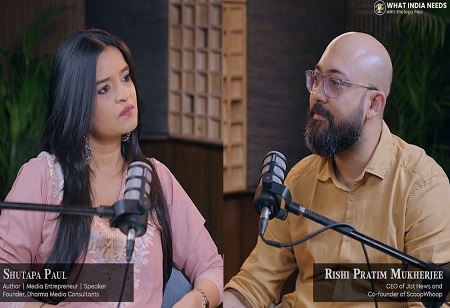The Rise of New Media: Can Social Media Journalism Stay Authentic in the AI Age?
With younger audiences turning to Instagram Reels, YouTube Shorts and WhatsApp forwards for news, traditional media houses are struggling to stay relevant. In a wide-ranging discussion on the “What India Needs!” podcast, Rishi Pratim Mukherjee, CEO of JIST Media and Co-Founder of ScoopWhoop, spoke with host Shutapa Paul about the shifting landscape of digital journalism. Mukherjee reflected on how creators today are chasing virality without a clear sense of direction, and why the battle to restore media credibility in the age of algorithms is far from over.
Is Traditional Media Dying? Or Just Evolving?
The media landscape is undergoing a shift. In a world where 71% of Indians prefer online news, with 49% relying on social media platforms for their news consumption, Mukherjee observed that legacy structures are crumbling under new realities. Much of this transformation is mobile-driven, with 96% of internet users in India accessing the web through their phones. “New media is here to rule,” said Paul, pointing to the explosive rise of digital platforms.
Mukherjee noted that while legacy media companies still exist, their formats and distribution strategies need to evolve urgently. “Some companies have been in denial till the captain has seen the iceberg,” he said, adding that the pace of digital disruption has outstripped the ability of many traditional media houses to adapt. As younger audiences shift to social media for news, digital-native publishers like JIST Media are experimenting with formats, tone, and distribution to stay ahead of the curve.
Content, Algorithms, and the Death of Predictability
The mechanics of digital success are also key. In today’s media economy, content virality is dictated less by loyalty and more by timing and format. “You don’t need a million followers. One topical and well-timed reel can hit two million views,” Mukherjee said.
However, creators are not always in control. Social platforms like Meta and YouTube operate like “walled gardens”, offering creators only a partial view of their performance data. Mukherjee likened the experience to “throwing darts in the dark”, where creators try to align with micro-trends without truly understanding platform dynamics. Paul and Mukherjee agreed that relying on third-party platforms for reach and insights leaves publishers with a limited view, making decision-making more reactive than strategic.
Fake News, AI, and a Fragile Ecosystem
Although the new media has opened up access and agility, it has also fuelled misinformation, more so now with artificial intelligence (AI) enabling sophisticated fakes. AI has transformed not only how content is created, but also how it can be manipulated. At JIST, AI tools are used selectively for tasks like scripting and generating quick voiceovers. But Mukherjee cautioned against over-reliance. “Fake news was already a problem. AI has only accelerated it,” he warned, pointing to the growing ease with which misinformation can now be produced and amplified. “We need to plan today so that we’re not in an AI mess tomorrow,” added Paul.
With trust in news plummeting, 40% of global audiences now distrust it, as per Reuters Institute, the conversation turned to the question of regulation. Mukherjee observed that the responsibility cannot rest solely with Meta or Google. He said that governments, platforms, and publishers must all play crucial roles in shaping effective regulatory frameworks.
As platforms evolve and AI blurs the lines between truth and manipulation, the battle for audience attention is growing ever more complex
The Bottom Line: Content with Credibility Wins
As the media industry evolves, Mukherjee believes that trust will be its most valuable currency. “Your tribe becomes your evangelist if you stay real,” he said. While virality may boost visibility, credibility ensures longevity. “Younger audiences know when you are faking it and smell clickbait,” added Paul, reinforcing the idea that today’s viewers are savvy, selective, and quick to disengage from insincere content.
As platforms evolve and AI blurs the lines between truth and manipulation, the battle for audience attention is growing ever more complex. However, as the discussion on “What India Needs!” revealed, the fundamentals haven’t changed. Building a loyal community still depends on clarity, consistency, and credibility.
“What India Needs!” is a thought-provoking podcast dedicated to exploring key topics crucial to India’s development. Our mission is to delve into pressing issues, engage with experts and thought leaders, and uncover actionable solutions for a more sustainable and prosperous future. Join us as we navigate the complexities of India’s growth, from policy and governance to technology and innovation, fostering informed discussions that inspire change and drive progress.
About the Authors
Shutapa Paul: The host of the “What India Needs!” podcast, Shutapa Paul, is an anchor, commentator, author, and media entrepreneur. After a successful career in journalism, she founded Dharma Media Consultants, an award-winning brand-building and communications company. Her deep knowledge and experience in the investing, startup, and impact ecosystem have earned her numerous accolades, including being listed in Businessworld’s 40 Under 40 (PR & CorpComm), Social Samosa’s 40 Under 40, and Agency Reporter’s 40 Under 40. She is also the recipient of Business World’s Excel Communications Personality of the Year award and ranks among LinkedIn’s “Top Voices.” With Shutapa Paul at the helm, the “What India Needs!” podcast promises to be a vibrant platform for discussing impactful ideas and insights.
Rishi Mukherjee: A seasoned entrepreneur with over 15 years in the digital media and media tech sectors, Rishi co-founded ScoopWhoop in 2013 and served as its COO until its acquisition in 2021. His leadership was instrumental in transforming ScoopWhoop from a startup into one of India's leading media companies, achieving over 1 billion annual views and generating $4 million in yearly revenue. He successfully raised over $6 million in funding and spearheaded the launch of key products like ScoopWhoop Hindi, Vagabomb, and OK Tested.
In 2023, Rishi established Jist Media, a digital media company focused on creating educational videos, which has since raised $1 million in seed funding and produced over 200 original videos per month, amassing more than 250 million views. He is dedicated to leveraging media and technology for social impact and advocates for diversity and inclusion within the workplace.
🍪 Do you like Cookies?
We use cookies to ensure you get the best experience on our website. Read more...






